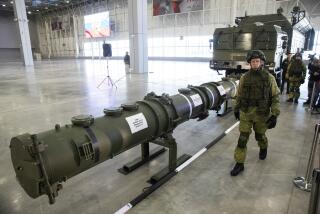Soviets Predict Missile Cutting Pact This Year
- Share via
GENEVA — The U.S.-Soviet arms control talks resumed here Thursday, and the chief Kremlin negotiator predicted acceptance this year of a treaty to limit intermediate-range nuclear missiles.
Alexei A. Obukhov, questioned by reporters as he greeted U.S. negotiator Maynard W. Glitman at the Soviet Mission here, declared, “We expect to have a treaty this year.”
And Glitman, head of the U.S. team concentrating on mid-range weapons, said, “We expect to have a good treaty.”
The optimistic attitude of the arms control experts raised hopes that negotiators will be able to agree on a reduction in intermediate-range nuclear missiles based in Europe.
Superior Conventional Forces
In Washington, President Reagan greeted the resumption of the talks with optimism. However, he stressed the concerns of the Atlantic Alliance that the removal from Europe of all nuclear weapons except for battlefield-scale ones could leave the allies vulnerable to the Warsaw Pact’s superior conventional forces.
And Secretary of State George P. Shultz, assuring the Western European nations that the United States has an “awesome” and flexible nuclear arsenal, said the NATO allies “shouldn’t be afraid to take yes for an answer to our own proposal” for missile reductions.
Here in Geneva, Obukhov and Glitman met for two hours at the Soviet Mission and then adjourned the discussions until Monday.
They were said to have worked out the framework for this round of talks.
The Soviets’ Obukhov did not present a draft of his country’s proposal for reducing intermediate-range missiles in Europe. But he is thought to be prepared to deliver the Soviet version of the treaty--discussed recently by Soviet leader Mikhail S. Gorbachev with Shultz in Moscow--in a matter of days.
The United States has already presented its draft of a treaty to reduce the number of missiles, anywhere from the current deployment to none on either side, with the stipulation that both sides would have equal numbers.
The two negotiating teams here will split into three groups to try to work out language for the provisions for arms limitations and verification of the limitations, plus protocols specifying how some of the complicated steps on inspection would be taken.
Gorbachev has offered to dismantle about 270 SS-20 missiles deployed against Western Europe on condition that the United States recall the Pershing 2 and cruise missiles stationed in North Atlantic Treaty Organization countries.
Both sides would be able to retain 100 warheads for the missiles, with the Soviets basing theirs in Asia and the Americans siting theirs in the continental United States.
The North Atlantic Treaty Organization currently has 108 Pershing 2 missiles and 208 cruise missiles as part of a planned deployment of 572 weapons scheduled for the end of 1988.
The American negotiating team in Geneva is waiting to see the precise language of the Soviet proposals--and how closely they conform to Gorbachev’s sweeping but vague statements made during the past few weeks.
Both the Soviets and the Americans have expressed interest in ridding Europe also of what are called shorter-range intermediate nuclear missiles, those of a range from 350 to 1,000 miles, as well as the longer-range intermediates, with ranges from 1,000 to 3,000 miles.
After the Thursday meeting, the two sides made no official statements.
Zero Option Fears
The talks are being watched with great interest by several of America’s NATO allies who are worried about the so-called zero option, the proposal under which all the intermediate missiles would be removed from Europe.
Defense experts in West Germany, Britain, France and Italy fear that if the Soviets should attain a nuclear-free Europe, the conventional military strength of the Warsaw Pact Communist nations would predominate over the Atlantic Alliance.
Some European ministers believe that pulling out U.S. nuclear missiles would leave America less committed to the defense of its European allies.
And a special task force of NATO officials is now meeting to work out a joint policy that Washington might adopt in determining how far to reduce the nuclear deterrent in Europe. A report that would enable the U.S. arms negotiators to proceed is expected within a couple of weeks.
U.S. officials have sought to dispel the fear that America’s nuclear deterrent force, now four decades old, is in the process of being scrapped.
For instance, Secretary of State Shultz appeared on a special television hookup Thursday with journalists in England, the Netherlands, West Germany, Belgium and Italy to emphasize that even if a zero option is negotiated, the United States would still provide its allies with a strong nuclear defense.
This would consist of nuclear weapons aboard aircraft and submarines, strategic missiles based in the continental United States, and the shortest-range weapons--the tactical or battlefield nuclear arms, those with a range of less than 350 miles.
Beyond those weapons considered in the current negotiations, said Shultz, American nuclear arms are still “quite awesome.”
Further, U.S. officials point out that the 350,000 American service personnel assigned to NATO forces should quell doubts about the U.S. commitment to the defense of Europe.
The Reagan Administration, in the ironic position of having suggested the zero option for mid-range intermediate missiles in 1981, was taken by surprise when Gorbachev suggested doing away with the shorter-range missiles as well.
American arms control negotiators believe that many European officials may be overreacting to the possibility that the intermediate-range missiles could be dismantled, and they fear that such doubts might hamper a genuinely profitable nuclear reduction agreement with the Soviets.
And such was the optimism in the air in Geneva that one veteran observer of the talks commented privately: “The two sides will have to work very hard not to get an agreement.”
Reagan, although expressing optimism Thursday, noted the doubts that remain over Moscow’s intentions. It was “U.S. and allied determination to maintain our security” that has brought the United States and the Soviet Union as close as they are now to an agreement, Reagan said in a written statement.
He also said the question of verifying mutual adherence to any pact must be resolved.
“We cannot make progress on this fundamental issue until the Soviets respond in detail to the comprehensive verification proposal which the United States has already made in Geneva,” the President said.
Ever since Shultz conferred with Soviet leaders in Moscow a week ago, Reagan and his aides have spoken encouragingly about the opportunities for reaching a pact to reduce to no more than 100 the longer-range, intermediate-class warheads in the arsenals of the United States and the Soviet Union.
“The United States returns to these negotiations determined to build on the progress” made in Moscow, he said.
Although some central issues are unresolved, Reagan said, “prospects for an INF (intermediate nuclear forces) agreement have moved forward.”
With the talks getting under way again in Geneva, the President reiterated his preference that the entire class of longer-range intermediate nuclear forces be eliminated.
Reagan called on the Soviets to elaborate their position on the shorter-range nuclear weapons, of which the United States has none in Europe. The Soviets are believed to have approximately 800 of these, and 130 launchers, in Europe.
Times staff writer James Gerstenzang, in Washington, contributed to this article.
More to Read
Sign up for Essential California
The most important California stories and recommendations in your inbox every morning.
You may occasionally receive promotional content from the Los Angeles Times.










